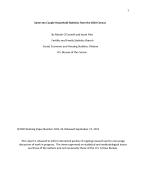Same-Sex Couple Household Statistics from the 2010 Census
Same-Sex Couple Household Statistics from the 2010 Census
Executive Summary
This paper will address the statistical aspects of the collection and presentation of data on same-sex couple households from the 2010 Census. Initial comparisons between the 2010 Census and the 2010 American Community Survey (ACS) indicated the 2010 Census number of same-sex couple households was 52 percent higher than the ACS estimate. Further investigation of this discrepancy indicates that the form structure of the 2010 Census for the follow-up component of the data collection phase may have caused sufficient data capture errors in the gender item that inflated the census counts, especially for the numbers of same-sex spousal households. These errors may have included mismarks in the gender item by opposite-sex couples or errors in the optical reading of the marks on the forms to inadvertently classify an opposite-sex couple as a same-sex couple. Even a very small percentage of these errors could have a significant impact on the overall estimate of same-sex couples.
This paper estimates that 28 percent of all same-sex couple households in 2010 Census tabulations are likely to be opposite-sex couple households. This problem is more severe for those couples who reported being spouses (62 percent) than unmarried partners (7 percent). This problem was most evident for households in the non-response follow-up (NRFU) phase of data collection where one partner’s sex in an opposite-sex household was incorrectly marked or captured in the processing phase of the questionnaire, resulting in a same-sex couple household. Approximately 10 same-sex couple households were incorrectly generated for every 1,000 opposite-sex households by these data capture errors in the gender item using NRFU forms. By comparison, this ratio was estimated to be approximately 3 per 1,000 opposite-sex households from mailout/mailback forms filled out by the respondent.
As the ratio of opposite-sex to same-sex spousal households is much greater than the ratio of opposite-sex to same-sex unmarried partner households, the effects of these errors are disproportionately greater on the numbers of same-sex spouses than unmarried partners. Since the proportion of same-sex households tabulated from the NRFU forms is higher in the South and through the upper Midwest, data from these areas are also more affected with inflated estimates than areas on the west coast and in northeast.
Estimates are presented in this paper for both same-sex unmarried partner and spousal households at the state-level that remove the households in the published tabulations that are suspected of being opposite-sex households. Data users can feel confident that the published data from Summary File 1 on the American FactFinder for the unmarried partner component of same-sex couple households is a reasonable portrayal of the size and relative geographic distribution of this population. However, data for the same-sex spousal component should be used only with great caution as they do not accurately represent the number of same-sex couple households where the householder was living with a spouse.
Changes in the Relationship Categories Between 2007 and 2008
The relationship question has several new categories in 2008. The “Child” category in 2007 has been expanded to “Biological child,” “Adopted child,” and “Stepchild.” Compare with caution as in previous years, respondents may have been including “children” other than biological, adopted, or stepchildren when they chose the category, “Child”. We also have two other categories, “Parent-in-law” and “Son/daughter-in-law” that have replaced “In-law.” Exercise caution when comparing the 2007 “In-law” to the 2008 categories as any “in-law” could have been included in this category by respondents in 2007 and earlier, especially brothers- and sisters-in-law. Combining “In-law” and “Other relative” for 2007 and the “Parent-in-law,” “Son/daughter-in-law,” and “Other relative” categories for 2008 is recommended.
Others in Series
Working Paper
Working Paper
Working Paper








